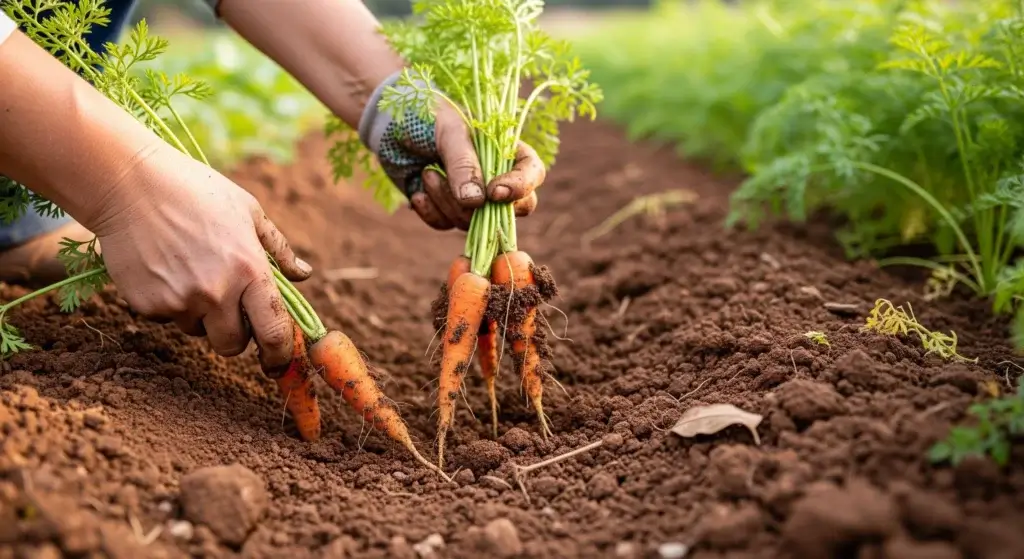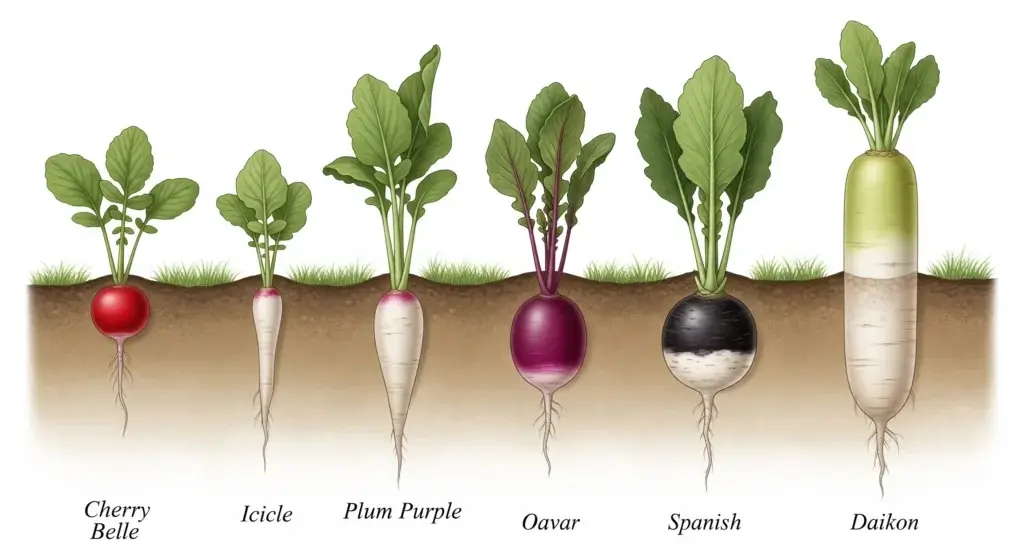
Companion planting is the practice of growing different plants together to improve their growth, health, and productivity.
This technique has been used for centuries, and it’s a great way to create a diverse and resilient garden ecosystem.
When it comes to tomatoes, companion planting can help repel pests, improve flavor, and even attract beneficial insects.
In this article, we’ll explore some of the best companion plants for tomatoes and provide you with tips on how to create a thriving garden oasis.
Best Companion Planting for Tomatoes
Beneficial insects & pest repellent
When it comes to companion planting for tomatoes, beneficial insects and pest repellents are a great place to start.
Here are some of the best plants to include in your tomato garden:
Basil
Beyond its culinary uses, basil serves as a formidable natural pest repellent in the garden.
Its aromatic oils effectively deter flies and other insects that might harm your tomatoes.
Additionally, planting basil alongside your tomatoes can enhance the flavor of the fruits, resulting in tastier harvests.
- Read also: Mastering the Art of Drip Irrigation for Tomatoes
- Read also: Troubleshooting Tomato Leaf Problems
Marigolds
These vibrant flowers are not only visually appealing but also serve as powerful allies in pest management.
Marigolds release compounds that repel nematodes, tiny soil-dwelling pests that can wreak havoc on tomato roots.
Moreover, their bright blooms attract beneficial insects like bees and butterflies, which aid in pollination and contribute to a thriving garden ecosystem.
Mint
Known for its refreshing scent and culinary versatility, mint also boasts natural repellent properties against common garden pests.
Planting mint around your tomato plants can help deter unwanted critters such as rabbits and deer, reducing the risk of damage to your precious crops.
Chives
These slender, onion-like herbs not only add a savory kick to dishes but also play a crucial role in pest control.
Chives emit compounds that repel aphids, tiny insects that can potentially damage tomato foliage and flowers.
By incorporating chives into your tomato garden, you create a protective barrier against aphid infestations while simultaneously enhancing the flavor profile of your tomatoes.

Pollinators
Pollinators are essential for any garden, and tomatoes are no exception.
Here are some of the best pollinators to include in your tomato garden:
Borage
With its vibrant blue flowers and cucumber-like flavor, borage is not only visually stunning but also a magnet for bees.
Bees are essential pollinators for tomatoes, and borage provides them with a rich source of nectar and pollen.
By incorporating borage into your garden, you can attract these industrious pollinators, ensuring abundant tomato harvests.
Alyssum
This delicate flowering plant is a favorite among pollinators due to its abundant nectar production and sweet fragrance.
Alyssum’s tiny blossoms act as a beacon for bees, butterflies, and other beneficial insects, drawing them to your tomato plants.
By interplanting alyssum with your tomatoes, you create a welcoming environment for pollinators, encouraging healthy fruit set and development.
Lavender
Known for its soothing scent and stunning purple blooms, lavender is a beloved addition to any garden.
Beyond its aesthetic appeal, lavender serves as a valuable ally in attracting pollinators such as bees and butterflies.
These winged visitors not only aid in tomato pollination but also contribute to the overall biodiversity of your garden.
Other helpful plants
In addition to beneficial insects and pollinators, there are many other plants that can help improve your tomato garden.
Here are a few of our favorites:
Beans
Beyond their nutritional value, beans offer an added advantage as nitrogen-fixing plants.
They have the unique ability to convert atmospheric nitrogen into a form that is readily available to other plants, thus enriching the soil with this essential nutrient.
Asparagus
Asparagus serves as a natural deterrent for tomato beetles, pests known to feed on tomato foliage and cause damage to the plants.
Planting asparagus alongside your tomatoes can help deter these beetles, reducing the risk of infestation and protecting your tomato crop.
Nasturtiums
Nasturtiums offer a dual benefit in the garden, serving as both a natural attractant for aphids and a flavor-enhancing companion for tomatoes.
Aphids, tiny insects that can damage tomato plants by feeding on their sap, are drawn to nasturtiums, diverting their attention away from your tomatoes.

Planting Plans to Avoid
While companion planting can provide numerous benefits for your tomato garden, it’s equally important to be mindful of plants that may have detrimental effects on your tomato plants.
Here are some planting plans to avoid:
Corn
While corn is a staple crop in many gardens, it’s not an ideal companion for tomatoes.
Corn has a high demand for water and nutrients, which can compete with tomatoes and potentially hinder their growth and development.
Fennel
Despite its culinary appeal, fennel is not a suitable companion for tomatoes.
Fennel produces compounds that can inhibit the growth of nearby plants, including tomatoes.
Planting fennel near your tomatoes may result in reduced vigor and yield for your tomato plants, making it wise to keep these two species separate in your garden layout.
Potatoes
While potatoes and tomatoes are both members of the nightshade family, they are best kept apart in the garden.
Potatoes are susceptible to various pests and diseases, including aphids and whiteflies, which can also affect tomato plants.
Brassicas
Brassicas, such as broccoli, cauliflower, and cabbage, are known to attract insect pests like aphids and cabbage worms.
These pests can feed on tomato plants as well, causing damage to foliage and reducing overall plant health.

Planning Your Garden Oasis
Creating your garden oasis starts with thoughtful planning and attention to detail.
Here are some essential tips to guide you in designing a flourishing tomato garden:
Spacing
Adequate spacing between plants is crucial for optimal growth and development.
Crowded plants can compete for resources like sunlight, water, and nutrients, leading to stunted growth and increased susceptibility to diseases.
When planting tomatoes, ensure they have enough room to spread out and thrive.
Sunlight
Tomatoes are sun-loving plants that thrive in full sunlight.
Choose a location for your tomato garden that receives at least six hours of direct sunlight per day.
Avoid planting them in areas shaded by tall trees or buildings, as insufficient sunlight can result in poor fruit development and lower yields.
Soil
Quality soil is the foundation of a healthy garden.
Tomatoes prefer well-draining soil rich in organic matter, such as compost, aged manure, or shredded leaves.
These organic amendments help improve soil structure, moisture retention, and nutrient availability, providing an optimal environment for tomato roots to thrive.
Watering
Consistent watering is essential for tomato plants, especially during the growing season.
Keep the soil evenly moist but not waterlogged, as overly wet conditions can lead to root rot and other diseases.
Water deeply and thoroughly, ensuring the moisture reaches the root zone.

Maintaining Your Thriving Ecosystem
Once you’ve planted your tomato garden, it’s important to maintain a thriving ecosystem.
Here are a few tips to keep in mind:
Watering
Proper watering is essential for the health of your tomato plants.
While tomatoes require consistent moisture, it’s important to avoid overwatering, as this can lead to root rot and other diseases.
Water your plants deeply and evenly, ensuring that the soil is moist but not waterlogged.
Fertilizing
Providing your tomato plants with adequate nutrients is essential for robust growth and abundant fruit production.
Choose a balanced fertilizer specifically formulated for tomatoes and apply it according to the manufacturer’s instructions.
Avoid over-fertilizing, as excessive nitrogen can promote lush foliage growth at the expense of fruit development.
Pruning
Regular pruning helps maintain the health and vigor of your tomato plants by removing diseased or overcrowded foliage and improving air circulation.
Start by removing any suckers that form in the leaf axils of the main stem, as these can divert energy away from fruit production.
- Read also: Unlock the Secret: Tomato Plant Watering Schedule
- Read also: Effective Strategies for Getting Rid of Tomato Hornworms
Conclusion
Companion planting is a great way to create a thriving garden oasis, and tomatoes are one of the best plants to include in your garden.
By incorporating beneficial insects, pollinators, and other helpful plants into your tomato garden, you can create a diverse and resilient ecosystem that will provide you with a bountiful harvest.
Remember to avoid planting certain plants near your tomatoes, and make sure to provide your plants with the right amount of sunlight, water, and nutrients.
With these tips, you’ll be well on your way to creating a thriving tomato garden that will provide you with a delicious and nutritious harvest for years to come.



